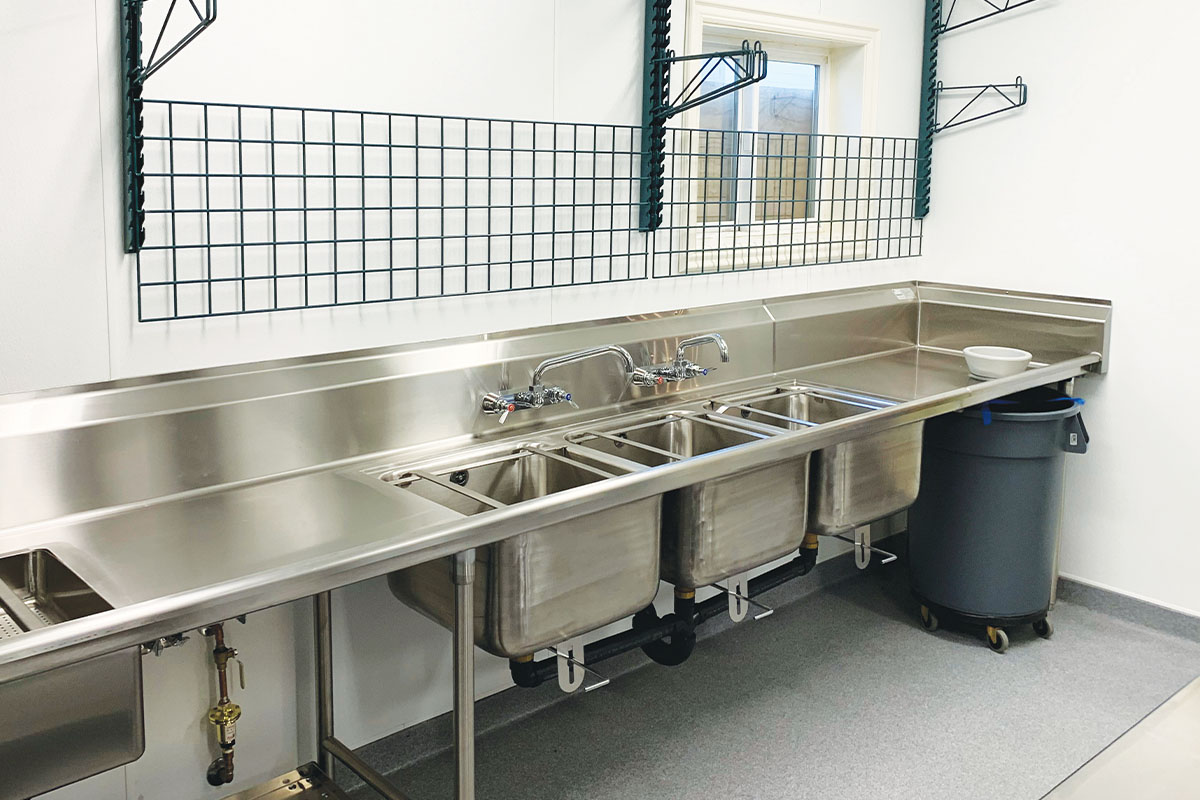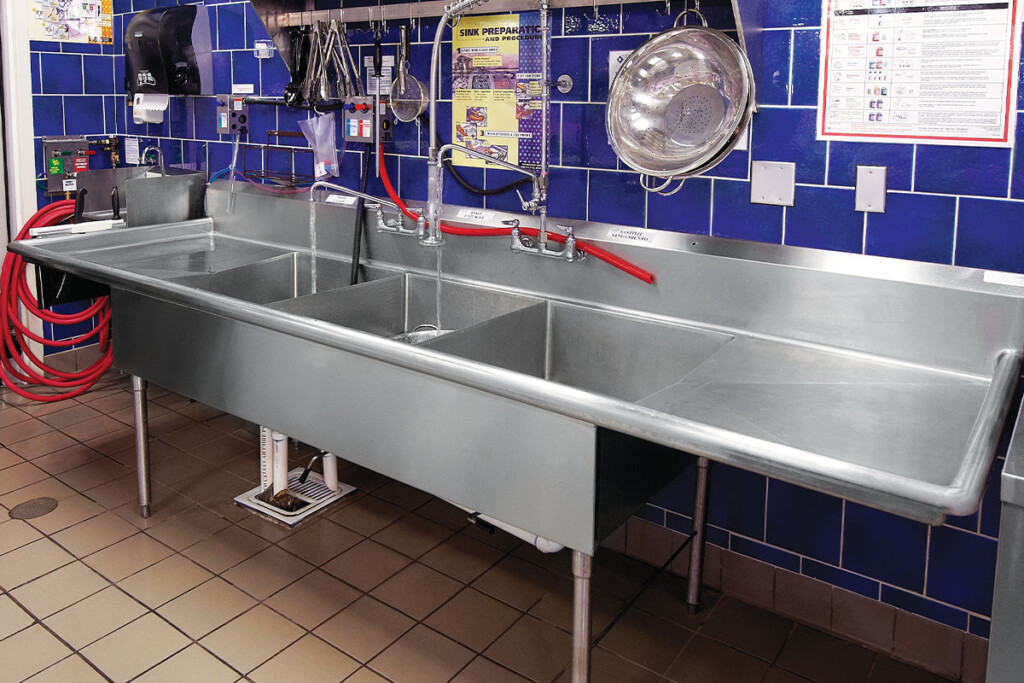Are you ready to take your commercial kitchen to the next level? A 3 compartment sink is the perfect way to keep things properly sanitized and organized.
This guide will show you all the benefits of having one in your commercial kitchen, so you can make sure to provide your customers with a safe and hygienic environment.
Having the correct equipment in a commercial kitchen is essential for any food service business due to the strict regulations and laws that are place to ensure the establishments protect their customers from risk of illness.
The three compartment sink is one piece of equipment which should be found in most commercial kitchens or food-handling areas as it can be used to effectively clean, rinse and sanitize items such as utensils and dishes through proper methods.
In this guide, we will discuss what a 3 compartment sink is, its components and how it can be used practically.

Brief overview of the importance of proper sanitation in commercial kitchens
Proper sanitation is a fundamental requirement in any commercial kitchen. A 3 Compartment Sink is a critical component of proper sanitation in such environments. It is the best way to ensure the cleanliness, safety and hygiene of an eating establishment’s staff and customers.
The three compartments are used for different cleaning tasks – washing, rinsing, and sanitizing. The first compartment is used for washing items with hot water and a detergent solution to dislodge any food particles or grease. The second compartment rinses away any dirt or soap residue, which leaves the items sparkling clean and free from germs. Items must then be immersed into the third compartment filled with sanitizer solution at a temperature of 75°F (24°C) to kill microorganisms such as bacteria that have survived any previous cleaning process! This helps limit cross-contamination between kitchen surfaces and ensures food safety regulations are being met.
A 3 Compartment Sink should be installed near each major food preparation area to ensure employees can easily follow these steps without having to travel long distances with dirty dishes or utensils! Furthermore, this setup requires kitchen staff to adhere strictly to approved cleaning practices documented in their establishments’ health & safety policies & procedures manual, which helps minimize their risk when it comes to serving customers with confidence!
Explanation of the 3 compartment sink and its significance in maintaining cleanliness

A three compartment sink is a requirement for most commercial kitchens, and for good reason. It provides a dedicated place for washing and sanitizing dishes, utensils, cookware and other kitchen equipment. The sink is typically divided into three sections: one for washing, one for rinsing and another for sanitizing. Each compartment serves an important purpose in the cleaning process.
The wash compartment is used to scrub dishes as well as any soiled surfaces or items with soap and hot water. Proper washing is essential to ensure that all food particles are removed. After being washed in this section, the items should be rinsed off with hot water before being placed in the next section–the rinse compartment. The rinse basin serves to rid your equipment of excess debris while simultaneously cooling it down slightly before being immersed in the sanitizing solution of the third area.
The sanitizing phase consists of submerging items into a chlorine or quaternary ammonium (quat) solution contained within the last area of the three part sink. When used correctly, this process kills any remaining bacteria on surfaces that could potentially cause contamination or foodborne illness if ingested by consumers. Therefore, it’s very important that each compartments are utilized correctly to ensure maximum safety and cleanliness in commercial kitchens; failure to do so may result in contamination or closure of your facility due to health code violations!
What is a 3 Compartment Sink?

A three-compartment sink, sometimes referred to as a 3-c sink, is a necessary appliance in commercial kitchens. It consists of three different basins that are typically connected and divided by two vertical partitions with partitions being slightly lower than the basin. This equipment is required by the food service industry standards and is necessary in order to meet health and safety regulations. These sinks are important for preparing, cleaning and sanitizing dishes, utensils, cookware, and other equipment. The three compartments allow for the water to be appropriately temperature regulated for proper sanitation when washing dishes and other items.
Each of the compartments has a different purpose when used together which helps promote efficient sanitation:
- The first compartment is usually filled with hot soap-water which can be used to pre-rinse dishes before going into the second compartment.
- The second compartment is usually filled with hot water (approximately 160°F) which can be used for scrubbing pots, pans, cutting boards, utensils etc. followed by rinsing them off in this bowl
- The third compartment contains a sanitizing solution (typically bleach or quaternary mixture) that kills bacteria remaining on items after they have gone through wash cycle in order to eliminate any potential cross contamination between surfaces like tables or kitchen counters exposed to raw foods as well as food servers who come into contact with customers’ plates or orders.
Description of the components of a 3 compartment sink

A 3 compartment sink is an essential component of a commercial kitchen. It consists of three interconnected basins, typically connected side-by-side, which are used to wash, rinse and sanitize food preparation items. The sink has the capacity to accommodate a variety of food preparation tasks such as washing produce, thawing meats and poultry, soaking dishes and cleaning utensils.
The 3 compartment sink is designed with drainboards at both ends for drainage of dirty water from the basin. It is available in both stainless steel and polypropylene materials that are highly durable, rust-resistant and easy to clean. The tubs have surfaces that provide good grip for scrubbing dishes and utensils as well as sloped sides for easy draining of water into the drains. Each basin has its own independent hot/cold water faucet to control the temperature of the water more precisely during cleaning operations.
The 3 compartment sink also includes a pre-rinse plumbing spout located between two connected basins which enables the operator to efficiently clean dishes after they have been washed in one basin while another vessel is filled with fresh rinse water in the adjacent basin. Built-in waste collectors, installed underneath each compartment, catch dishwashing debris such as particles of food or other refuse during operation ensuring all food waste flows directly into sewage pipes rather than clogging up kitchen pipes or entering public waste lines inappropriately.
Diagram illustrating the setup of a 3 compartment sink
A commercial kitchen requires specialized equipment that can keep up with food preparation, serving and cleanup. One such item is the three compartment sink (sometimes referred to as a triple sink). This sink arrangement is designed for washing, rinsing, and sanitizing dishes of various materials and sizes. It also helps to ensure that your kitchen meets certain standardized sanitation requirements.
The setup of a three compartment sink consists of three individual basins: one for washing dishes, one for rinsing dishes, and one for sanitizing them with hot water or chemical disinfectant. The first two divisions should be connected by a drain board; this allows water to run off into the sanitation basin. By arranging all three basins in this way and using appropriate detergents or chemical sanitizers throughout the process, you have a more efficient workflow that can save you time and money.
Following is an image illustrating the placement of a 3 compartment sink in a commercial kitchen:
Why is a 3 Compartment Sink Important in Commercial Kitchens?
It is important to have a 3 compartment sink in commercial kitchens because it helps to ensure that proper sanitation procedures are followed and that equipment is kept clean. The 3-compartment sink allows the user to complete three separate stages of washing, rinsing and sanitizing that together make up an important part of food safety preparation.
The first stage, washing, involves using hot soapy water at a temperature of at least 110°F (43°C) to physically remove debris from plates, utensils, pieces of equipment and other items. The second stage is rinsing in cold water to remove any residual soap from the items being washed. Finally, all items should be completely submerged in a separate compartment containing a sanitizing solution for two minutes before drying with a clean towel or paper towel.
Using the 3-compartment sink helps to prevent cross-contamination between food items being handled by kitchen staff, as different areas can be designated for cleaning meat items versus vegetable produce or cutlery and plastic utensils. Implemented correctly, this system will also prevent food surfaces from becoming contaminated by germs and bacteria brought into the kitchen on workers’ hands or clothing during periods when no other forms of sanitation are available. By ensuring that all three steps are followed correctly each time they are used, commercial kitchens can rest assured that their surfaces remain sanitary even after heavy use.
Explanation of the role of a 3 compartment sink in preventing cross-contamination
In commercial kitchens, securing food safety is of the utmost importance. All kitchen staff must be knowledgeable of the proper procedures and protocols so that standards of safe food handling can be met and maintained. The 3 compartment sink plays a key role in preventing cross-contamination and keeping a sanitary work environment.
Each compartment has its own specific use, reinforced by the designated placement. The first compartment is often used for washing dishes or utensils. The second compartment contains a sanitizing solution, such as diluted bleach or quaternary ammonium compounds, to kill any remaining bacteria on washed items before being reused; this portion may also contain detergent for scrubbing down equipment surfaces. The third section of the sink is purely for rinsing with potable water; this ensures that any residual sanitizer from the second basin does not contaminate food contact surfaces through contact or splashing of dirty water while washing dishes. It is important to note that rinsing should occur after both cleaning and sanitizing processes have been completed in order to prevent backward contamination.
By following proper procedures when using a 3-compartment sink, kitchens are able to avoid cross-contamination by properly cleaning and sanitizing items between uses, allowing staff to maintain safe levels of hygiene while preparing meals for patrons.
Discussion of health code regulations that require the use of a 3 compartment sink
The use of a three compartment sink is a requirement in most commercial kitchens. This requirement stems from health code regulations, which are generally intended to protect the public health. A three compartment sink has three separate compartments that are used to help meet these standards and maintain a safe environment in which food is prepared and served.
Each compartment of the sink must be cleaned using specific methods to meet health codes. The first compartment is used for washing. The temperature of water should be between 110°F (43°C) and 150°F (66°C). When cleaning hands, dishes, utensils, pots, or pans the water will become contaminated very fast so it needs to be changed periodically depending on how much washing is taking place.
The second compartment should be used for rinsing items that have been washed with warm water in the first compartment using very hot water at a minimum temperature of 180°F (82°C). This helps get rid of any lingering contaminants from foods that were just washed off in the first compartment as well as provides additional sanitization by killing germs with heat.
The third and final part of this process consists of immersing items such as plates, utensils, etc., into the third section that contains hot sanitizing solution with a minimum required temperature between 155-165 ° F (68-74 ° C). This helps kill any remaining germs on cleaned or sanitized dishes or other items before they go back into service. Items immersed in this solution should remain there for at least 30 seconds before being rinsed off with cold water and dried completely before returning them back into service.
Using a 3 compartment sink correctly can help maintain good hygiene practices necessary for proper food safety and prevention against foodborne illnesses due to contamination from equipment or human contact during preparation time in commercial kitchens.
Conclusion
A 3 compartment sink is an essential piece of equipment for the safe and hygienic operation of any commercial kitchen. By having a designated area for food preparation, dishwashing and sanitizing, meal preparation and cleaning can be done in a fast, convenient and efficient manner.
When purchasing a 3 compartment sink, keep in mind the type of utensils that will be used with it and the space requirements. Make sure to find one that will match your existing decor while being able to fit into the space you have available. With proper maintenance, this versatile utility tool will give your business years of reliable service.
FAQ’s
What is the purpose of a 3 compartment sink?
A 3 compartment sink is used for washing, rinsing, and sanitizing dishes and utensils in a commercial kitchen.
What is a three compartment sink food safety?
A three compartment sink is an important tool for ensuring food safety in a commercial kitchen, as it allows for proper cleaning and sanitation of dishes and utensils to prevent cross-contamination and the spread of harmful bacteria.
Do I need a 3 compartment sink?
If you are operating a commercial kitchen that serves food, you will likely need a 3 compartment sink to comply with health and safety regulations.
What are the 3 types of sink we used in the kitchen?
The three types of sinks commonly used in a kitchen are the handwashing sink, the prep sink, and the 3 compartment sink.
Which is the proper procedure for 3 compartment sink?
The proper procedure for using a 3 compartment sink involves washing dishes in hot soapy water in the first compartment, rinsing them in the second compartment with clean water, and then sanitizing them in the third compartment with a sanitizing solution.
How many sinks are required in a commercial kitchen?
The number of sinks required in a commercial kitchen will depend on the specific regulations of your area, but generally, you will need at least one handwashing sink and one 3 compartment sink.
How do you secure a 3 compartment sink?
A 3 compartment sink should be securely mounted to the wall or floor to prevent tipping or movement during use.
What is the proper temperature for a 3 compartment sink?
The proper temperature for a 3 compartment sink will vary based on the specific cleaning solution being used, but generally, hot water should be used for washing and rinsing, while the sanitizing solution should be at a temperature of at least 75°F.
Does a commercial bar need a 3 compartment sink?
If a commercial bar is serving food or using utensils that require proper cleaning and sanitation, they will likely need a 3 compartment sink to comply with health and safety regulations.
Why do you need a sink?
A sink is necessary for cleaning and sanitizing dishes and utensils, as well as for washing hands and preparing food in a commercial kitchen or any place where food is prepared.
See More
- Best portable sink 2023
- Best workstation sink 2023
- Best pedestal sink 2023
- Best work station sink 2023
- Best work station sink 2023

